McKinney’s historic red-brick Cotton Mill with glass paneled windows sits on the east side of Highway 5 about a mile from downtown. Soon, plans for redevelopment at the site could bring one five-story multifamily building and three seven-story multifamily buildings to the fields south of the mill bordered by Anderson and Burrus streets.
The multifamily buildings would add 1,135 units to the mostly industrial area. Plans also include office spaces, artist lofts and an expansive, outdoor community area.
The project is headed by Texas-based real estate development firm Presidium Group, which requested several design exceptions on the site plan for the Cotton Mill Redevelopment Project, among them a request to build the multifamily buildings up to seven stories; while the area is zoned for buildings of three or four stories, it allows for height variances. The Casey family, which has owned the mill since 1996, and developer Presidium said the density that seven-story complexes will bring is needed to support the coming retail, restaurant and community space.
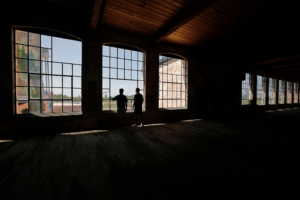
The Cotton Mill managers McCall Casey, left, and his brother Chandler, whose family own the mill, are seen in the inside space of the mill, Wednesday, Aug. 23, 2023, in McKinney. Casey family is planning to use this space to make a boutique hotel.(Chitose Suzuki / Staff Photographer)
City staff did not support the request for height variance, but council members voted 5-2 to approve site plan variances, including the height variance, during a July meeting. It was the first time someone has used a design exception to increase building height in the McKinney Town Center zoning district, unique to the downtown area.
“The Cotton Mill and Presidium’s shared vision of bringing this 113-year-old district back to its former glory starts with bringing the right amount of density to drive it,” said McCall Casey, Cotton Mill manager. “The seven stories of multifamily will bring the population to create a thriving district for all ages and cultures.”
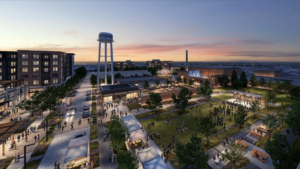
Rendering of the Cotton Mill Redevelopment plan to include four multifamily buildings, office spaces, artist lofts and an expansive, outdoor community area.(Courtesy of Sasaki / Courtesy of Sasaki)
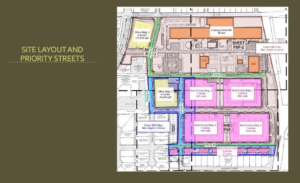
The project redevelopment includes plans for four multi-family buildings and two office buildings.(Courtesy of City of McKinney / Courtesy of City of McKinney)
Many area residents look forward to such a development in their neighborhood. Other residents, however, worry about increases in traffic and the scale of the project being too much for the 32.1-acre space, near small, single-family neighborhood homes.
“We have car washes, Encore Wire [a wire and cable manufacturer] is expanding, the airport, a lot of things that we don’t need in our everyday lives that don’t benefit us or don’t benefit our quality of life,” said Jessica Thibodeaux who lives within walking distance of the mill. “We understand change is coming whether we like it or not, and we’d rather have change come to the area that can offer us something positive.”
Coming plans to restore mill to its ‘former glory’
The Cotton Mill was established in 1910 and became a community center by 1930, said Chandler Casey, Cotton Mill manager. The families who worked at the mill lived in small homes surrounding the site. The community had its own school, band, baseball team and recreation center.
Beth Beck, executive director of the MillHouse — a membership-based, creative co-work space for existing, or aspiring, small business women in creative fields — is a tenant at the Cotton Mill and pointed to how the families that once lived around and worked at the mill created an “extremely progressive mixed-use development.”
“It was really created as commerce for community in its inception, so what I really see in this [redevelopment plan] is commerce for the community again, it’s just in a different way,” Beck said during the July council meeting. “We’re looking at a comparable mixed-use facility and project. It really will bring a different kind of vibrance back to this community “

A 1939 group shot of the Cotton Mill employees are seen inside the mill, Wednesday, Aug. 23, 2023, in McKinney. (Chitose Suzuki / Staff Photographer)
Terry Casey bought the mill nearly 30 years ago, and the Casey family has been stewards of the site since. Parts of the existing Cotton Mill have been remodeled, and inside its expansive 176,000 square feet lies artist studios, a ceramic studio, an art gallery, a coming recording studio, office spaces, an event hall and space rented out by the MillHouse. Most recently, a coffee shop opened in the mill’s east end. There are also plans for a 66,000-square-foot boutique hotel and restaurant, to be built within the existing Cotton Mill structure.
But the Caseys have always imagined more.
“It has been my goal to bring the Cotton Mill to the thriving facility that it once was — a cultural destination that complements the special aspects of downtown and the east side,” McCall said. “We want to bring it back to its former glory. We are proud to be the caretakers, and we’re proud to be part of the east side.”
The five-story multifamily building will include wrap-around parking, and the three seven-story multifamily buildings will include two floors of podium-style parking with five stories of living space. The multifamily buildings will help support the community space, slated to include a lawn/pavilion area, food and beverage retailers, an outdoor stage for music, small pocket-parks featuring art sculptures and artist designs, playground areas, space to play games such as dominoes, event space for car shows/markets and food truck spots possibly for local business owners to rent.
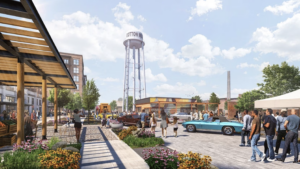
Rendering of the Cotton Mill Redevelopment plan to include four multifamily buildings, office spaces, artist lofts and an expansive, outdoor community area.(Courtesy of Sasaki / Courtesy of Sasaki)
“A lot of people in the community cook but don’t have a storefront, so introducing food trucks and having a minimal rent requirement, having Eastside community members operate it, so you’re giving that local resident opportunity to grow their business, too,” Chandler said.
Further, plans include two four-story office buildings totaling about 200,000 square feet and 27 three-story townhome style “artist lofts,” which will be for sale and allow the local artist community to not only have a place to work but also be in a collaborative environment.
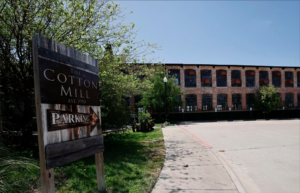
The Cotton Mill is seen, Wednesday, Aug. 23, 2023, in McKinney. (Chitose Suzuki / Staff Photographer)
The project is slated to break ground during the second quarter of 2024, with plans to start building the community space in conjunction with the five-story, 252-unit multifamily building followed by one of the seven-story 318 unit multifamily buildings. The first phase will have 10% of the units set aside for those earning 80% or less of the area median income. The entire site, including its office spaces and artists lofts is projected to be complete over a five- to seven-year period, according to Presidium President of Development Mark Farrell.
“We truly think that it could be a jewel of McKinney, a destination of the United States,” McCall said. An economic impact study by Catalyst Commercial Inc. found the economic impact over a 20 year period would be $933 million and would generate $38 million in tax revenue to the city.
City Concerns, resident feedback
Even so, the city did not support the request for the height variance, expressing concern that the proposed scale and size of the apartment buildings compared with the existing cotton mill structure and other buildings in the area would be incompatible not only for the immediate area around the cotton mill site but also in consideration of the downtown area overall.
There was also concern around the adjacency to an existing single family home in the area — the only remaining home from what was once a neighborhood made up of families who worked at the mill. One of the four-story, 63-foot-tall office buildings would have come up to the home’s property line, however following city concern, the Cotton Mill worked with the homeowner to purchase the home, McCall said.
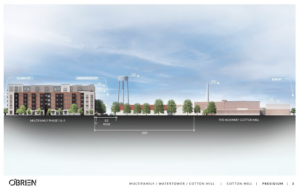
Renderings of the proposed redevelopment at the Cotton Mill show scale of planned multifamily buildings compared to surrounding single family residences and the existing Cotton Mill.(Courtesy of Presidium / Courtesy of Presidium)
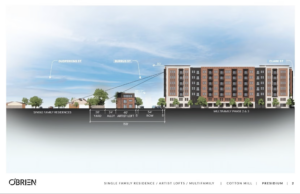
Renderings of the proposed redevelopment at the Cotton Mill show scale of planned multifamily buildings compared to surrounding single family residences and the existing Cotton Mill.(Courtesy of Presidium / Courtesy of Presidium)
“Given the degree of change that they were looking for, from what that max allowed height was from the zoning and what they were proposing, that was a concern to us,” said Jennifer Arnold, director of planning for the city. “The scale and compatibility of three seven-story 85- to 90-foot-tall buildings in an area where the closest tallest building is around 35 to 45 feet, in our opinion, the change to the skyline in an area that is historic was not appropriate.”
Some residents agree that the scale is just too much.
Charles Wattley, pastor at St. Mark Baptist Church, grew up near the Cotton Mill site. The church, founded in 1879, has been at the corner of Elm and Wilcox streets — a short walk from the mill — for 30 years.
“The cotton mill has been a great neighbor, but this project is an overbuild for that location. Yes, it is an apartment complex, but it is an apartment complex on steroids.” He is worried about the traffic that the development could bring and said he does not think the surrounding neighborhood residents will like the height of the buildings.
“Who wants to walk out of there and look at seven stories?” Wattley said.
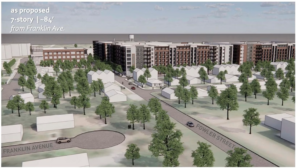
The multi-family buildings will range between five and seven stories tall. City staff noted the redevelopment project is adjacent to a residential neighborhood.(Courtesy of City of McKinney / Courtesy of City of McKinney)
However, when Farrell began working with the Casey family about two years ago, he and his associate Cynthia Palomo knocked on about 75 doors and talked to about 30 people in the surrounding area to invite them to talk about the development plan and listen to their thoughts and concerns.
“Without exception, everyone was excited about the project; they wanted it there,” Farrell said during the council meeting. The team at Presidium and the Cotton Mill has also contacted East McKinney community leaders and engaged city officials to ask how to make the development inclusive — a place “that people in the neighborhood after dinner can say, ‘let’s take a walk, let’s go sit by a fire pit, let’s go look at the fountain or maybe go to the stage for some entertainment,’ ” Farrell said.
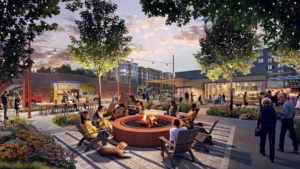
Rendering of the Cotton Mill Redevelopment plan to include four multifamily buildings, office spaces, artist lofts and an expansive, outdoor community area.(Courtesy of Sasaki / Courtesy of Sasaki)
Deborah Bradford, assistant pastor at New Jerusalem Baptist Church, was one of the community leaders Farrell contacted a couple years ago. She said she appreciated that the desires of the neighborhood were considered and discussed, and, while she said she loves the ideas that were presented, she said it’s too much in too small of a space.
“We would still like to see those types of things carried out, but in a different method, a different way,” she said.
But neighbors such as Mark and Jessica Thibodeaux can’t wait to enjoy the space with their two young kids and said they are excited about the possible opportunities for small business owners, as the couple owns their own food truck.
“The size of the building, yeah it’s going to be big, but that’s a small price to pay to be able to receive a lot of amenities that a lot of other residents around McKinney get to enjoy, but we just don’t.”

![[DMRE Deal] McKinney’s Historic Cotton Mill will be Site of Seven-Story, Multifamily Units](https://dmre.com/wp-content/uploads/2023/09/Screenshot-2023-09-21-at-4.31.27-PM.png)
